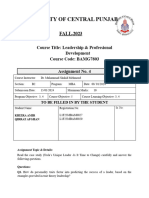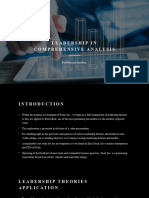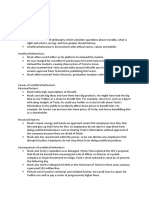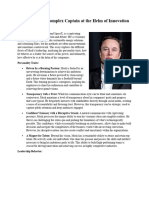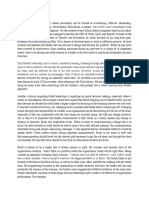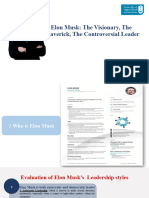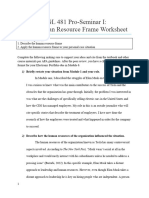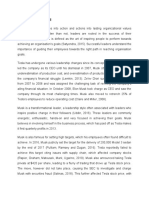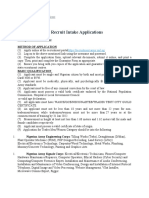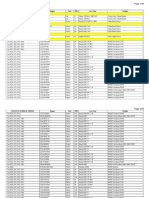Running Head: Week 4 Assignment: Leadership Matters!
Case Study
Leadership Matters!
Louken Salvan Pluviose II
Keiser University
Introduction to Managerial/Organizational Behavior
Instructor: Dr. Tom Burgett
2 April 2025
1
�Running Head: Week 4 Assignment: Leadership Matters!
Introduction
Elon Musk is perhaps one of the most controversial and equally transformative business leaders,
known for his bold vision and unrelenting drive, as exemplified by his work at Tesla and
SpaceX, as well as his influence on other companies. He single-handedly changed the landscape
of electric vehicles, space travel, and renewable energy, which earned him the status of a
visionary. However, Musk’s leadership also accounts for controversies like Tesla’s self-
destructive micromanagement, emotional outbursts, and social media gaffes. Musk has yet to be
proven wrong regarding his unconventional approaches to business and growth, but, to the
contrary, they have led to high-profile executive exits and reputation damage. Amidst this chaos,
questions arose regarding the long-term effectiveness of his leadership. This assessment analyzes
his influence through the lens of organizational behavior. Specifically, the disconnect between
Tesla’s potential and operational hardships as seen through the 3-Step Problem Solving Approach
(Kinicki & Fugate, 2020). On the individual level, Musk's brilliance is overshadowed by
impulsive tweets that invite SEC fines, a refusal to delegate work, exasperated teams, and public
brawls with stakeholders. On a more macro level, Tesla suffers from insufficient governance and
an organizational structure where Musk’s rule suppresses opposing views and alternative
frameworks, as evidenced by the reckless attempt to fully automate Model 3 production.
In parallel, Musk must pair his boundless audacity with accountability while maintaining the
Tesla metric of incorporating innovation into all projects, balancing coherence with innovation
without stifling his boundless drive to push boundaries, all while being held accountable. Thus,
striking a balance between leading operational excellence and stakeholder esteem, alongside
2
�Running Head: Week 4 Assignment: Leadership Matters!
emotional resilience, demonstrates how true innovation can shine brightly in tandem with
stability.
Step 1: Defining the Problem
Tesla’s greatest concern is the significant gap between its self-set aspirational goals and the
current state of its operations. Tesla aspires to become a world-class leader in the electric vehicle
and green energy industries, characterized by exceptional efficiency and innovation.
Unfortunately, the current state is marked with leadership instability, chronic underperformance,
production bottlenecks, and public perception issues. The principal reason lies within Elon
Musk’s far-from-traditional management style, which has propelled Tesla to unprecedented
heights while exposing the company to considerable systemic risk.
A. Multilevel Problem Analysis
1. Single-Point Problem: Individual Level (Musk’s Leadership Style)
a) Micromanagement of Subordinates: Musk tends to micromanage,
exercising undue control over operational details at the expense of middle managers, leading to
decision-making bottlenecks. Musk’s policy of having the final say on vehicle part design
changes has considerably lengthened production timelines (Kinicki & Fugate, 2020).
3
�Running Head: Week 4 Assignment: Leadership Matters!
b) Emotional Volatility: Musk’s outwardly visible anger (e.g., social media
antics, unkind comments during earnings discussions) has promulgated a volatile environment
that increases workplace stress and attrition levels. Former executives note that his volatile
outbursts led to the sudden termination of engineers who challenged his decisions (Enderwick,
2018).
c) Decreased Ceding of Control. Even with the company's growth, Musk
still retains control of key decisions, thereby neutralizing the erosion of authority at the senior
staff level.
This has led to a very high turnover of C-suite positions, including several CFOs and engineering
VPs who reported feeling ignored (Sonnenfeld, 2019).
2. Group/Team-Level Dysfunctions
a) Autocratic Decision-Making: Musk’s top-down management** allows
little to no room for team member contributions, as employees are likely to be punished for
speaking out. Tesla’s engineers have reportedly refrained from presenting differing answers to
Musk’s vision due to fears that he would not entertain them (Davenport, 2018).
4
�Running Head: Week 4 Assignment: Leadership Matters!
b) Fear-Based Culture: The paucity of psychological safety has resulted in
teams becoming risk-averse, whereby employees focus on not getting things done instead of
pushing boundaries. In the Model 3’s “production hell,” engineers became reluctant to challenge
Musk’s automaton plan due to the undue delays until it was too late (Kinicki & Fugate, 2020).
c) Cross-Functional Silos: Disruption of departmental coherence as a
result of Musk’s direct involvement in numerous sectors like design, manufacturing and software
has caused a rift between the R&D, marketing and production teams.
3. Organizational-Level Consequences
a) Reputational Damage: Musk’s doubtful public comments, including the
unfounded “pedo guy” claim, coupled with smoking weed on Joe Rogan’s talk show, have, along
with other steps, led to a loss of trust, especially among consumers and investors.
b) Regulatory and Legal Risks: The SEC’s fraud charges levied against
Musk’s “funding secured” tweet, which culminated in a $40 million fine and his removal from
the board chair position, underscore governance lapses and erratic decision-making (SEC, 2018).
5
�Running Head: Week 4 Assignment: Leadership Matters!
c) Operational Inefficiencies: Musk’s production delays (Cybertruck and
Semi) as well as quality control issues (panel gaps in early Model 3s) highlight some of the
systemic challenges and failures of oversight in supply chain and manufacturing processes.
Those in the strategic management field would cite Musk’s unwavering, visionary commitment
alongside his *disjointed tactical execution as his most paramount concern posing the most
significant trouble for the company.
Musk’s transformative vision, coupled with his *lack of systematic approach to execution, came
at a cost for Tesla:
1. Sustained turnover in C-suite roles, as Musk’s reckless, high-octane approach to
management led to chronic understaffing at the VP level, with 36+ executives leaving since
2018.
2. Exceeding deadlines and going over budget due to nonsensical paradigms (e.g., FSD-
orbital delay).
3. Diminishing confidence among stakeholders, leading to significant fluctuations in
stock prices and volatile consumer sentiment.
6
�Running Head: Week 4 Assignment: Leadership Matters!
Step 2: Identifying the Problem
Following the Organizing Framework (Kinicki & Fugate, 2020), we evaluate the inputs,
processes, and outcomes that describe Tesla’s leadership difficulties.
A. Person Factors (Inputs)
1. Personality: Musk exhibits a high acceptance of new ideas, indicating visionary
thinking, but possesses low emotional stability due to impulsive reactions and public outbursts
(Davenport, 2018).
2. Transformational Leadership: He employs a transformational leadership
approach, inspiring his employees with bold visions (Buss, 2017). The absence of contingent
reward leadership (e.g., feedback, delegation) results in many unproductive activities.
3. Overconfidence Bias: Musk dismisses expert opinions due to an unwarranted
high estimation of his capabilities, as evident in the ill-fated Model 3’s automation strategy
(Kinicki & Fugate, 2020).
7
�Running Head: Week 4 Assignment: Leadership Matters!
B. Situation Factors (Inputs)
1. Industry Constraints: Competition within the EV market intensifies as
innovation accelerates, further amplifying Tesla’s propensity to take risks.
2. Weak Corporate Governance: The absence of a sound board to oversee Tesla
gave Musk free rein to indulge in his reckless behavior, including SEC infractions (Sonnenfeld,
2019).
3. Public Attention: Given the controversies surrounding Musk, his celebrity
status amplifies the consequences of his actions, as seen in instances such as the podcast where
he smoked marijuana and the defamation lawsuits.
C. Processes (Individual, Group, Organizational)
Decision Making: The Implementation of a Kanban system proposed by Toyota would have
likely garnered employee engagement; however, the lack of employee inclusivity results in a
relative disregard for ideas and a top-down decision-making approach.
1. Emotional Intelligence: His behavior, particularly his comments about a rescuer
being a “pedophile,” is damaging to Tesla’s reputation (Kinicki & Fugate, 2020).
8
�Running Head: Week 4 Assignment: Leadership Matters!
2. Crisis Management: Tesla lacks clear PR procedures, which allows Musk’s
tweets to create stock market fluctuations.
Step 3: Recommendations
To address Tesla's leadership challenges, the following solutions are proposed.
1. Improve Tesla’s Governance (Tesla & Musk)
a) Appoint an Independent Chairman: This blocks Musk’s absolute power by
ensuring he is overseen (Sonnenfeld, 2019).
b) Social Media Policies: A PR team should oversee Musk’s tweets to minimize
legal risks, such as SEC fines.
2. Address Musk’s Low Emotional Intelligence (EQ)
a) Executive Coaching: Assists Musk in self-regulation and understanding others’
emotions (Goleman, 1995).
9
�Running Head: Week 4 Assignment: Leadership Matters!
b) Restrict Operational Decision Making: Allow the COO to make production
decisions so that Musk can devote his attention to new ideas.
3. Improve Tesla’s Collaborations
a) Encourage Employee Feedback: Through anonymous surveys, employees can
report issues without fear of retribution or retaliation.
b) Cross-Functional Teams: Eliminate silos by inviting engineers, marketers, and
production personnel to participate in decision-making.
4. Advanced Crisis Management
a) PR Training For Executives: Provides uniform messaging during controversial
proceedings.
b) Withheld Information regarding Production Delays: Tell the public before they
have to postpone delivery to customers (ex. Model 3).
10
�Running Head: Week 4 Assignment: Leadership Matters!
Legal/Ethical Challenge: Employee Autonomy vs. Corporate Policy
The Claire’s incident highlights a serious ethical conflict that necessitates balancing an
employee’s autonomy with corporate policy and the well-being of a child. The case studies
examine how policy constraints at the corporate level can conflict with the moral agency of
frontline workers, particularly in terms of safeguarding a person’s autonomy. From the
perspective of organizational behavior, this situation illustrates policy and system misalignment
resulting from a lack of ethical training. Employees like Raylene Marks experienced the conflict
of following orders within a stratified bureaucracy that ignored consent frameworks. What ought
to have been included in Claire's policy manual about child assent was relevant governance
oversight. Store managers, buoyed by the absence of policies delineating the rights of lower-level
employees, would force employees to perform trivial tasks, such as ear piercing on agitated
children. Such procedures not only promise psychological injury to these minors but also carry
the risk of reputational and legal injury to the corporation, as witnessed in the public outcry after
Marks’s whistleblowing.
To resolve these problems, Claire needs to make organizational changes based on the ethical
principles of organizational behavior. First, aligning corporate policy to require explicit consent
from the child, independent of any parental influence, would enable the company to
contemporarily comply with child welfare norms and allow employees to serve as ethical
subadapters. Second, managers would potentially avoid coercive situations as a result of
balancing mandated business processes and duty of care by teaching supervisors about trauma-
11
�Running Head: Week 4 Assignment: Leadership Matters!
informed decision-making during basic manager training. Coercive power is often justified as a
legitimized performance carrot. Ultimately, the establishment of procedures to protect
whistleblowers on ethical grounds will empower employees to report ethical misconduct without
fear of retribution, thereby fostering a sense of psychological safety and promoting the
possibility of receiving constructive feedback that encourages accountability. All these changes
would reduce legal exposure and increase Claire's reputation as a socially considerate employer,
which, in the retail business where trust determines profitability, is crucial. Adopting these
policies, Claire's will be able to transform the piercing controversy into a discussion about
exemplary leadership in corporate policy reform.
Conclusion
Musk’s leadership is a perfect example of the benefits and problems associated with visionary
entrepreneurship. Musk's bold vision has disrupted multiple industries, but his personal
micromanagement, volatility, and anti-Tesla governance have consistently eroded the firm’s
stability. Heightened Tesla Control Measures and improving the emotional governance of Musk,
alongside fostering team frameworks, would help achieve balance and attain more sustained
innovation.
Additionally, organizations like Claire’s face dilemmas in enforcing their policies alongside
ethics and must ensure that employees have the flexibility to act in the best interest of relevant
stakeholders. Successful leadership, however, requires far more than having a vision. It demands
12
�Running Head: Week 4 Assignment: Leadership Matters!
empathetic emotional responsiveness, adaptability, and accountability, qualities that represent
long-term success.
13
�Running Head: Week 4 Assignment: Leadership Matters!
References:
Buss, D. (2017). Elon Musk: The driving force behind Tesla. Entrepreneur Press.
Davenport, C. (2018). The Space Barons: Elon Musk and the Quest to Colonize the Cosmos.
PublicAffairs.
Enderwick, B. (2018). Leadership Gone Rogue: The Dangers of Unchecked CEOs. Harvard
Business Review, 96(4), 54-61.
Goleman, D. (1995). Emotional Intelligence: Why It Matters More Than IQ. Bantam.
Kinicki, A., & Fugate, M. (2020). Organizational behavior: A practical, problem-solving
Approach (3rd ed.). McGraw-Hill.
Sonnenfeld, J. (2019, February 12). Why Tesla's Board Must Rein in Elon Musk. Yale Insights.
Retrieved April 2, 2025, from
https://insights.som.yale.edu/insights/why-teslas-board-must-rein-in-elon-musk
14
�Running Head: Week 4 Assignment: Leadership Matters!
Worktech Academy. (2025). The future of leadership in tech-driven industries Retrieved April 2,
2025, from https://www.worktechacademy.com
15













